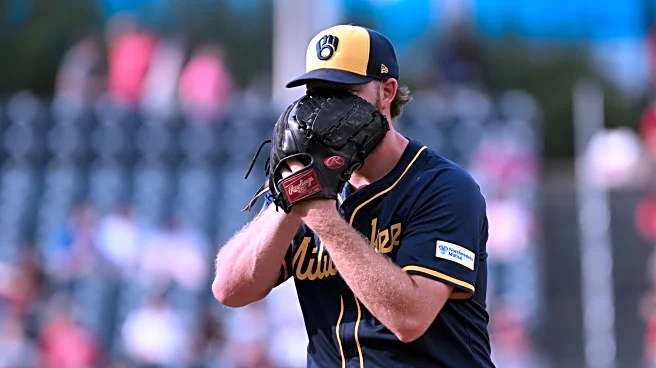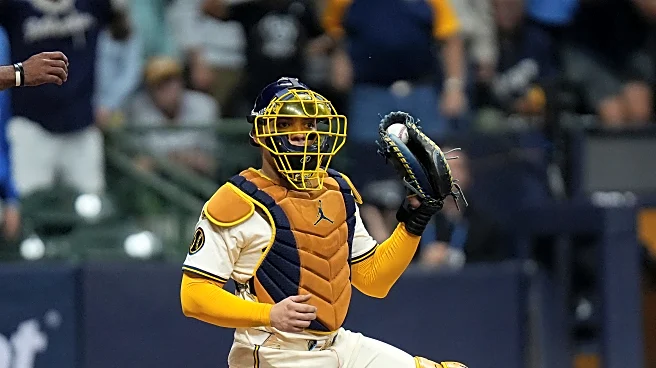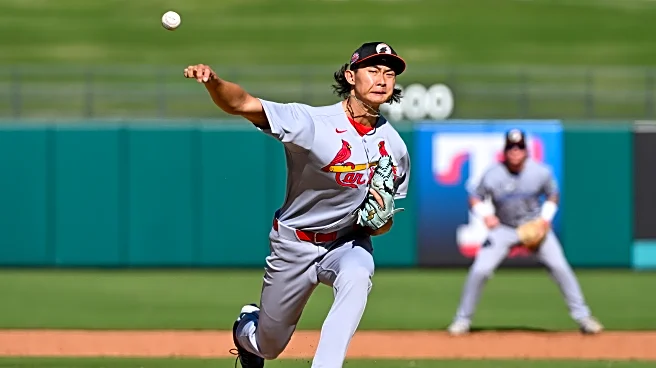Second baseman Brice Turang was, by most measures, the Brewers’ best hitter in 2025. Turang was named to the All-MLB Second Team after posting 5.6 bWAR and slashing .288/.359/.435, all career highs. His
batting average and OPS+ were also both tied for the best among Brewers’ regulars (excluding Andrew Vaughn, who had less than half the plate appearances of Turang, Contreras, Yelich, Frelick, etc.). Turang absolutely demolished his previous high-water marks for home runs, OPS, batting average, RBI, and pretty much every other relevant hitting stat.
Much of the reason that Turang’s season-long stats look so good was his performance in August. Turang won NL Player of the Month after hitting .343 with a 1.095 (!!) OPS and 10 home runs. Ten home runs are the most that any second baseman has hit in a single month since Marcus Semien hit 12 in September of 2021. It’s also more home runs than Turang hit in each of his first two seasons with Milwaukee. Turang came down to earth a bit in September but still posted significantly above-average numbers (.835 OPS, good for fourth-best on the Brewers in the month of September).
Then October rolled around. Turang hit .114 with a .391 OPS in nine postseason games. He had two hits in Game 1 of the NLDS, but had just two total hits over the final eight games. One of those hits was a 416-foot bomb of a home run to give the Brewers a much needed insurance run in Game 5 of the NLDS. The other hit (79.2 exit velocity) was a Yoshinobu Yamamoto cutter that Turang sliced into left field for a single. Other than those two at-bats, Turang was hitless after Game 1 of the NLDS.
I know that most of the Brewer regulars struggled to make hard contact in the Dodgers series. Turang, however, posted the lowest OPS out of the six Brewers regulars who had at least 20 at-bats. The only Brewers with a lower OPS than Turang in the 2025 playoffs were Brandon Lockridge (two plate appearances), Isaac Collins (10 plate appearances), and Joey Ortiz (who struggled at the plate for much of the season).
Since I write about the Brewers, I watched almost every game last year. While watching the NLCS, it seemed like Turang was trying harder to hit home runs compared to his at-bats back in August. His swing appeared (to me at least) as if it were slightly longer to garner more power, rather than focusing on making solid contact. With that being said, I didn’t actually go back and watch the film from August and compare it to the NLCS.
So, did Turang’s swing change from August to October? Players sometimes slump at the plate, especially over a sample size as small as nine games. Turang also wasn’t the only Brewer who had a rough October. Was Turang’s slump due to a change in hitting mechanics? If so, what should he do going into next season to remain a formidable presence at the plate?
How was Turang’s weight distributed?
First, let’s establish what Turang’s swing looked like this year. Turang changed a few things about his swing heading into 2025, but the most significant change occurred in his weight distribution. As overviewed in an August video on MLB Network, Turang’s 2024 stance (on the left) was fairly even. In 2025 (on the right), Turang started with more of his weight on his back foot.

Hitting a baseball involves a weight transfer from the back foot to the front foot. Many batters will start with their weight evenly distributed, shifting their weight back (“loading up”) as the pitcher winds up and then forward as they swing. Turang’s 2025 stance is a little more “pre-loaded”; in other words, his weight is already on his back foot, so he doesn’t have to shift his weight as far back before transferring his weight to his front foot.
What’s the advantage of a “pre-loaded” stance? For some batters, standing pre-loaded helps them simplify the hitting motion and time the ball better, allowing them to make contact more often. Turang’s main statistical deficiency at the plate prior to 2025 wasn’t a lack of contact, it was a lack of power. He would often hit the ball while already out on his front foot. Pre-loading his stance allowed Turang to keep his weight on his back foot longer. Instead of transferring his weight at the moment of contact, 2024 Turang would have already transferred the majority of his weight prior to making contact — thus making it harder to drive the ball.

Now, let’s look at a photo of Turang’s home run against the Cubs in Game 5 of the NLDS.

Even though the result of the at-bat was a home run, Turang’s weight distribution just after making contact looks much more similar to 2024. He’s still on his back foot slightly more than he was in 2024, but he’s much more upright and clearly leaning less on his back foot than he was in the regular season.
Other potential explanations as to why Turang struggled in the playoffs:
Is Turang trying too hard to hit home runs?
I wouldn’t classify Turang’s swing this year as having had a prominent uppercut. While Turang increased his average launch angle (8.6 degrees) by roughly a degree this year, that’s still a good amount flatter than the major league average. His average launch angle ranked 159th steepest out of 175 qualified batters. If you’re a bigger believer in the eye test, watch this home run from March:
Cal Raleigh ranked first in baseball with an average launch angle of 25.2. Watch one of his home runs for comparison’s sake. The pitch is a little low in the zone, but it’s not below the zone! That’s an uppercut if I’ve ever seen one.
Per Statcast, in the Dodgers series (where he had just one hit) Turang posted a maximum launch angle of 32 and put more balls in play with negative launch angles than positive ones. Multiple Brewers (Jake Bauers, Isaac Collins, and William Contreras, to name a few) posted launch angles of over 60. So, no, I wouldn’t say Turang was trying too hard to hit the ball in the air. Launch angle doesn’t always tell the whole story, but he doesn’t appear to have had a more prominent uppercut in October.
Did Turang’s swing get any less efficient?
Turang has never had an incredibly compact swing — his swing features a leg kick (more pronounced this year), a high stance, and a pronounced one-handed follow-through. However, Turang is historically short (efficient) through the strike zone. He has the big leg kick and starts with his hands high, but he also does a good job of keeping his bat in the zone, keeping his back elbow close to his side, and staying compact/quick until his follow-through.
Turang’s swing can best be described as rotational (as opposed to linear, which focuses on the arms, wrists, and hands as the primary source of power). Rotational hitting can help smaller hitters maximize their power by relying on the hips and core to generate power. Again, this is why the weight transfer stuff is important. A guy like Aaron Judge can theoretically be more inefficient with his swing mechanics because he’s big enough and strong enough to hit one out anyway. Turang doesn’t have as much room for error.
Another aspect of rotational hitting is the timing between the rotation of the lower body and the swing. If your upper body lags too far behind your lower body/the rotation of the hips, you lose power. The same is true if you hit the ball without having fully rotated your hips.
Let’s look at an example — a home run that Turang hit against the Diamondbacks on August 27. The pitch is inside, which helps Turang keep his elbow in, rotate into the ball, and drive it over the right-field fence. He doesn’t let his hands lag behind. His swing is in line with his lower body, exploding through the ball all in one motion.
Same thing here:

This pitch is in almost the exact same location as the home run against the Cubs — again, his swing stays nice and compact through the strike zone.

Now, was his swing any different in October? Let’s go back and look at that home run in Game 5 of the NLDS.

His swing basically looks the same as it did on those October home runs. His elbow is tucked in. He hits the ball while his hips are rotating, not before or after. Other than his weight distribution (as detailed above), this is a great swing from Turang.
Now, let’s look at a couple of times where Turang didn’t make solid contact to see if his swing changed at all. The first example I thought of was his RBI fielder’s choice in Game 4 of the NLCS off of Dodgers reliever Anthony Banda. This at-bat was a good example of situational hitting, as you obviously want to put the ball in play with a runner on third and less than two outs. It also wasn’t a hard-hit ball. According to Statcast, Turang’s grounder had an exit velocity of 65.8 mph. Here’s what Turang looked like while making contact:

Another example is Turang’s strikeout to end Game 1 of the NLCS. He swung under this pitch (because it was roughly a foot above the strike zone), but at the moment where he would have made contact, his form looked like this:

On both of these, his hips are in the same position as his home runs from August. His elbow isn’t noticeably further out in either clip, either. This tells me that his swing is staying relatively consistent. In short, I wouldn’t say his swing got significantly longer or loopier. His mechanics don’t seem like the most plausible explanation as to why he struggled in the playoffs.
The one thing that stands out to me is that Banda’s pitch to Turang lands in the outside third of the strike zone. Turang ended up pulling this ball weakly to the right side. Any hitting coach will tell you to go with the ball. If somebody throws you an outside pitch, try to stay back on it and hit it to the opposite field. I can’t tell for sure without the side angle, but it looks to me like Turang is too far out on his front foot (inefficient weight transfer) because he’s trying to pull the ball. That, unlike his launch angles, could be a sign that Turang was trying too hard to hit for power. Turang does have demonstrably more home-run power to his pull side; only five of his eighteen home runs this year were hit to the left of the sign in center field.
———————————————————————————————————
So, what was the reason for Turang’s rough October? A couple of his at-bats point to him being too far out on his front foot. A couple other at-bats point to him trying to pull the ball when he shouldn’t. On the other hand, his mechanics mostly stayed consistent from August to October. That’s a very good sign.
If I were a betting man, I would bet good money that the version of Turang that we saw in the last two months of the season is here to stay. His power surge wasn’t a result of launch angle wizardry; rather, the 2025 version of Turang transfers his weight in a significantly more effective way. That, in conjunction with his short swing, points to the sustainability of his newfound power stroke. I’d be surprised if he doesn’t end up around 20 home runs again next year.
To improve on his 2025 performance, Turang will need to continue keeping his weight back through the point of contact and avoid trying to pull balls on the outside third of the plate. If he can do that while continuing to play the Platinum Glove-caliber defense that he’s capable of, Brice Turang could take the next step and become a legitimate superstar.












